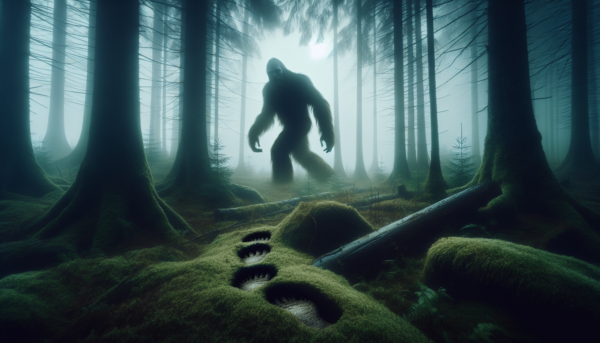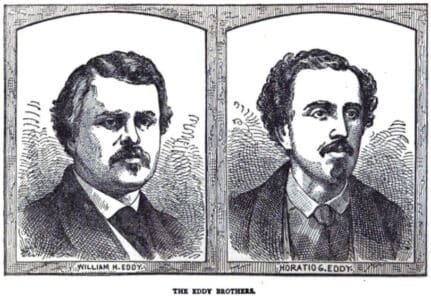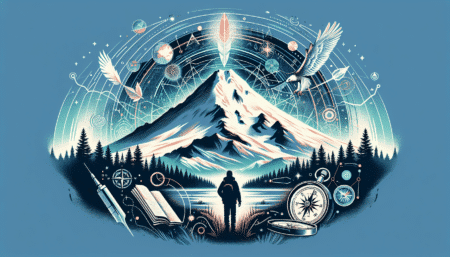- Introduction
- The origins of the Bigfoot legend
- Bigfoot in modern research
- Bigfoot and the indigenous cultures
- Famous Bigfoot sightings and their influence
- Conclusion
1. introduction
Bigfoot, also known as Sasquatch, is a legendary apparition from North American folklore that has captured the imagination of many for years. This cryptic creature, often described as large, hairy and ape-like, supposedly inhabits the forests of North America, preferably in the Pacific Northwest region of the US and Canada. Despite numerous reports of sightings, impressive footprints and even eyewitness accounts, the Sasquatch remains a mystery that has yet to be acknowledged by science. The fascination surrounding this creature is evident in books, documentaries and television shows, with the search for evidence of its existence continuing to captivate many adventurers and researchers.
This article explores the connections between ancient myths and modern sightings of Sasquatch by examining its origins in Bigfoot legend and its presence in modern research. We also highlight the role of Sasquatch in indigenous cultures and take a look at famous Bigfoot sightings that have sparked public interest and debate. Join us as we delve into the world of cryptozoology and the mysterious cryptids in search of the hidden truth behind the legends of this unique primate.
2. the origins of the Bigfoot legend
Different versions of Bigfoot exist in the indigenous communities of North America, often under different names and with slight variations in appearance and behavior. These stories and myths are an integral part of the culture and offer a fascinating insight into the perception and meaning of these creatures in different tribes.
The influence of the Patterson-Gimlin film
- Popularization of the name "Bigfoot": The name "Bigfoot" was widely popularized by the Patterson-Gimlin film released in 1967, which supposedly shows a Bigfoot-like creature walking through the woods.
- Controversies and debatesThe film has sparked much controversy and debate since its release. While some experts claim that it is a hoax, others defend the authenticity of the footage.
- Comprehensive analysesThe film was intensively analyzed and examined. Some aspects of the footage have been refuted, while other questions remain unanswered.
- Significance for the Bigfoot phenomenonThe movie has contributed significantly to the public's fascination with Bigfoot and fueled the search for evidence of its existence.
The emergence of the modern Bigfoot myth
- First reports in the 1850sThe legend was first reported by Native Americans in Northern California in the 1850s and gained popularity in the late 1950s.
- 1958 - A decisive yearThe name "Bigfoot" was popularized in 1958 by Jerry Crew, a bulldozer operator for a logging company in Humboldt County, California, after he discovered large, human-like footprints.
- The role of the mediaAndrew Genzoli, a journalist for the Humboldt Times, published an article about the footprints, which led to nationwide attention. He suggested that the footprints could be from a relative of the Himalayan Yeti and coined the term "Bigfoot".
These historical events and depictions played a major role in shaping the modern image of Bigfoot and bridging the gap between ancient lore and contemporary interest.

3. bigfoot in modern research
In modern research into the phenomenon of Bigfoot, there are a variety of approaches and opinions. While some researchers believe the existence of such a creature is possible, the majority of the scientific community is skeptical of the idea. Here are some of the current research approaches and findings:
Scientific studies and DNA analyses
- The Sasquatch Genome ProjectThis project has analyzed over 100 videos and performed DNA tests on 111 hair, blood and tissue samples. The results show unique DNA sequences that differ from human and animal DNA. Despite these findings, there is no recognition in the scientific community.
- Modern methodsResearchers use DNA analysis, thermal imaging cameras and molds of footprints to find evidence of Bigfoot. However, these techniques have not yet provided conclusive evidence.
Skeptical perspectives and scientific criticism
- Lack of concrete evidenceDespite numerous claims and alleged sightings, there is no verifiable evidence such as bodies, bones or clear physical evidence of the existence of Bigfoot.
- Criticism from expertsMany scientists, including anthropologists and zoologists, regard the available "evidence" as the results of misidentifications of known animals or as a hoax. The studies and results from cryptozoology are often rejected as not scientifically sound.
Cryptozoology and the fascination with the inexplicable
- Cryptozoology as a fieldAlthough often considered a pseudoscience, cryptozoology continues to attract many amateur researchers and enthusiasts. This community uses a variety of methods to investigate the existence of mysterious creatures.
- Social science perspectivesRecent academic work explores how the social sciences can benefit from engaging with cryptozoology. This approach offers new insights into the cultural significance of cryptids and the human fascination with the mysterious.
These research approaches and opinions show how complex and controversial the topic of Bigfoot is in modern science. The search for Bigfoot remains an exciting and challenging field that arouses both skepticism and curiosity.
4. bigfoot and the indigenous cultures
In the indigenous cultures of North America and parts of Asia, stories and legends about creatures that resemble Bigfoot are deeply rooted. These creatures are often seen as more than just mythological creatures - they are an integral part of spiritual and cultural heritage.
The Sts'ailes faith
The Sts'ailes, located in the Fraser Valley of British Columbia, view Bigfoot not only as part of their oral tradition, but as a supernatural being with the ability to shape-shift and communicate with animals. These characteristics emphasize the profound connection between Bigfoot and the natural world that is central to many indigenous cultures.
The protector of the forests: Ts'emekwes
The Squamish Nation, also from British Columbia, tells of a creature called Ts'emekwes. Similar to Bigfoot, Ts'emekwes is seen as a protector of the forest and its resources. He is believed to have healing powers and the ability to grant wishes, which emphasizes his role as a kind of guardian or guardian of nature.
Kwiluks and Kwalla: Mysterious creatures of the Lummi and Cowlitz
The Lummi Nation in Washington State speaks of Kwiluks, a powerful being that can influence the weather and communicate with animals. Kwalla, a legend of the Cowlitz Tribe located in the mountainous regions of Southwest Washington and Northwest Oregon, has similar traits. Kwalla is described as tall, hairy and human-like, which is similar to the typical description of a Bigfoot.
Sasq'ets of the Quinault Indian Nation
The Quinault Indian Nation of the Olympic Peninsula in Washington State tells of Sasq'ets, another powerful and mysterious being who can control the weather and speak with animals. These abilities re-emphasize the spiritual significance and deep connection to nature that Bigfoot holds in many indigenous tales.
Global parallels
Interestingly, similar creatures are also found in various parts of Asia, such as China, Vietnam, Malaysia and India. This universal presence of Bigfoot-like creatures in folklore and legends of different cultures points to a common human fascination with the mysterious and inexplicable.
The recognition and respect for these creatures in Indigenous lore shows how deeply Bigfoot and its relatives are embedded in cultural and spiritual understanding. It is important that research in this area respects indigenous taxonomies and names, as they often refer to imaginary or spiritually significant creatures.
5. famous Bigfoot sightings and their influence
The fascination with Bigfoot has spawned numerous sightings and stories over the years, ranging from simple eyewitness accounts to controversial film footage. These events have not only piqued the public's curiosity, but have also reinforced the cultural significance of Bigfoot as a modern myth.
The Patterson-Gimlin film
Perhaps the best-known proof of Bigfoot's existence is the Patterson-Gimlin film from 1967, which shows a large, hairy creature running through a forest in Northern California. Despite skepticism that the figure could be a human in a gorilla costume, this film remains central to the Bigfoot legend.
Confession by Ray L. Wallace
In the late 1950s, Ray L. Wallace caused a stir when he admitted to faking Bigfoot footprints with wooden feet. This confession caused many to question earlier and later sightings, but also contributed to the creation of the myth.
Global sightings
Similar creatures have been spotted not only in North America, but also in other parts of the world. From the "Snowman" in the Soviet Union to smaller Bigfoot-like creatures in the rainforest of West Sumatra, these reports show that the legend of Bigfoot is a global phenomenon.
Influence on pop culture
Bigfoot has found a permanent place not only in cryptozoology, but also in pop culture. From movies to series to books, the depiction of Bigfoot has often helped to maintain public interest in this mysterious creature.
Scientific and skeptical views
Despite its popularity and the many claimed sightings, Bigfoot remains scientifically unproven. Many researchers and skeptics point to the lack of concrete evidence such as bones or other physical remains that would confirm such a species.
The reports and sightings of Bigfoot, whether true or fictional, have undoubtedly helped to keep the legend alive and fascinate researchers and laymen alike. Whether as a frightening creature or a protective forest figure, Bigfoot remains an integral part of modern mythology and continues to capture the imagination of people worldwide.
6. conclusion
Through the study of the Bigfoot phenomenon, it became clear that belief in this legendary creature is deeply rooted in human culture, from the ancient lore of indigenous peoples to modern sightings and scientific investigations. The study of this mysterious creature illustrates the human propensity to explore the unknown and push the edges of our understanding of the natural world. It highlights the fascination we have with the mysterious and inexplicable, and the desire to find answers to questions that lie beyond the boundaries of conventional science.
In conclusion, Bigfoot represents more than just folklore or an object of ridicule; it symbolizes the eternal human question of what lurks beyond the known world. Although the scientific community has yet to acknowledge the existence of such a creature, interest in cryptozoology and worldwide coverage of Bigfoot continues. This ongoing dialog between belief and skepticism, between myth and empiricism, challenges us to continually question our ideas about the impossible and remain open to the infinite possibilities of our world.
Further questions and answers about Sasqutch
What is the Canadian name for the mythological creature Bigfoot?
In Canada and also in the state of Washington, Bigfoot is known as Sasquatch, a term that comes from the language of the indigenous people living there and means "hairy man" or "hairy giant".
In which regions are the most Bigfoot sightings reported?
Most reports of Bigfoot sightings come from the mountainous regions of the USA and Canada, especially the Rocky Mountains and the Appalachians, where sightings are reported particularly frequently.
What distinguishes Bigfoot from the Yeti and the Snowman?
The main difference between these creatures lies in their regional association. The Yeti is associated with the Himalayan region, while Bigfoot originates from English-speaking North America. The term snowman, on the other hand, was coined by sensationalist journalists.
Can Bigfoot be considered a monster?
Bigfoot, also known as Bigfoot, is a mythical creature from North American legends that is said to have been sighted mainly in the Rocky Mountains and the Appalachians. In Canada, the creature is known as Sasquatch, which means "hairy giant" in the language of some indigenous people. Whether it can be described as a monster is subjective and depends on the interpretation of the legends and reports.
















